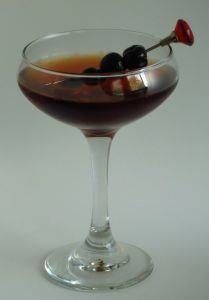 Strong bitter-sweet liqueurs are often welcome additions to cocktails, and we use them frequently. Chartreuse brings welcome herbal notes, maraschino brings cherry and almond flavors, and Campari brings deep vegetal bitterness balanced with a fruity, almost candy sweetness. It’s this latter we’ll be talking about today.
Strong bitter-sweet liqueurs are often welcome additions to cocktails, and we use them frequently. Chartreuse brings welcome herbal notes, maraschino brings cherry and almond flavors, and Campari brings deep vegetal bitterness balanced with a fruity, almost candy sweetness. It’s this latter we’ll be talking about today.
Campari is an Italian aperitif liqueur that is typically served in simple preparations for cocktail hour, like spritzers. We more typically add it to cocktails though, where it can be used in volume to balance other strong flavors, or in small amounts to add structure, interest, or balance to a drink. First though, what does it taste like on it’s own?
Campari
- Nose: Sweet fruity note to start, like cherry hard candy. Very strong vegetal bitterness like wormwood. Bitter orange peel. Dry, dusty aromas like baked earth.
- Palate: Initial hit of sweetness with red fruit hard candy, much like the nose. Notes of orange peel, clove and peppermint on the mid-palate with hints of root beer. Then very, very bitter green vegetal notes on the finish with a long bitter aftertaste.
But of course we’re all about mixing. 😉 First up, we have the Negroni, a classic cocktail where Campari features very prominently.
- 1 oz gin
- 1 oz sweet vermouth
- 1 oz Campari
Stir all ingredients with ice. Strain into a glass. Garnish with an orange twist. Cheers!
- Nose: Really strong orange to start, with a little bit of sweet hard candy. Some vegetal bitterness. Waxy lemon, like furniture polish though not unpleasant. Little bit of cinnamon and juniper.
- Palate: Sweet hard candy and orange to start. Cinnamon, clove, mint and juniper on the mid-palate. Vermouth speaks up at the beginning of the finish, offering bitter spicy wine notes. Finish is bitter with dark bread/pumpernickel flavors. As it warms up, orange notes start showing up on the finish. Nice mouth feel, rich enough to have some weight, but satiny rather than heavy.
When we first started our cocktail trajectory, we actually found the Negroni to be way too bitter for our liking. However, over time our palates have adjusted. They’re still quite bitter, but tasty. They’re definitely not a starter cocktail unless you really like bitter things.
Next up is one of our original cocktails. This one demonstrates how a small amount of Campari can really add to the cocktail without overwhelming it. It’s much more approachable in our opinions, while still giving the drinker a taste of what Campari is like. This cocktail came about because we frequently have leftover cherry syrup, either from Luxardo maraschino cherries or our own brandied cherries, so we wanted to see if we could use it in some interesting way rather than throw it out.
- 1 1/2 oz calvados or apple brandy
- 3/4 oz rye or bourbon
- 3/4 oz sweet vermouth
- 2 barspoons Campari
- 1 barspoon Maraschino cherry syrup
Stir all ingredients with ice. Strain into a glass. Garnish with a cherry (or several :)). Enjoy!
- Nose: Strong cherry to start. Yeasty, spicy apple like a danish, then sharp apple with a bit of barrel wood and funk, like a cask would smell if you were aging cider. Whiskey barrel wood notes.
- Palate: Very strong sweet apple to start. Tart pie cherry and rye spice on the mid-palate. From the mid-palate into the finish, slight menthol and tobacco notes. Malty grain and wood barrel notes on the finish. Underpinning of herbal bitterness throughout.
What Campari brings to this particular drink is that it balances out the drink, providing some herbal bitterness to counter the sweetness. This contrast helps bring out the fruit notes of the cherry syrup and the apple brandy too, in our opinions.
As we mentioned above, we originally found Campari a little too intense, but over time we’ve come to like it’s extreme bitterness. That bitterness doesn’t mean you should shy away from it though. If it is too much for you in large quantities, look for drinks that use it in small amounts. Much the same way that bitters round out and add complexity to a drink, so can Campari. Salut!




